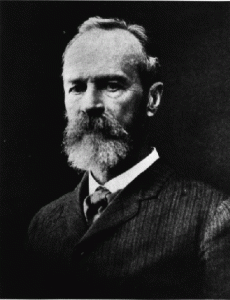 The New York Times Week in Review, blessedly (and following the fabulous journal The New Atlantis), quotes William James on attention. The point, naturally, is yet another condemnation of our relentlessly multitasking, over-busy mental society. But there is much more at work in this pregnant piece:
The New York Times Week in Review, blessedly (and following the fabulous journal The New Atlantis), quotes William James on attention. The point, naturally, is yet another condemnation of our relentlessly multitasking, over-busy mental society. But there is much more at work in this pregnant piece:
To James, steady attention was thus the default condition of a mature mind, an ordinary state undone only by perturbation. To readers a century later, that placid portrayal may seem alien—as though depicting a bygone world. Instead, today’s multitasking adult may find something more familiar in James’s description of the youthful mind: an “extreme mobility of the attention” that “makes the child seem to belong less to himself than to every object which happens to catch his notice.” For some people, James noted, this challenge is never overcome; such people only get their work done “in the interstices of their mind-wandering.”
While perhaps on the one hand he is making the wizened philosopher’s usual gripes against the young, there is something bolder going on as well. James is talking about the constituent things of personhood, the requisites. As a person matures—that is, comes into being himself—he becomes a person by making clear the line between self and world. No longer does the world utterly dictate the person; now the person begins to be, with focused attention, nothing but himself.
This is a common idea, of course, and not James’s invention, only his little implication. We expect—ideally—a coherence in people that mirrors the coherence we expect in ideas. And coming into that personhood is a process. It develops and “comes into its own.” Half a century after James, the popularizing psychologist Carl Rodgers could write a book called On Becoming a Person. Like the whole swath of 20th century popular psychology, Rodgers’s goal is control, or in his terms, “self-actualization.” Being a person means being an agent, a dominion, a soul, which rules over personhood and its extensions. Becoming so coherent as to be actual.
Incidentally, coherent personhood has been the assumption behind rational government (all but Louis XIV’s Le etat, c’est moi), especially republican democracy. Voting, opinion polls, representation, and constitutions all depend on the assumption that citizens are coherent persons.
Attention, of course, has had religious value across traditions for all time—the capacity of centering prayer and meditation to alter consciousness is well attested to. And so, meanwhile, is this sense of personal coherence that goes with it. In the Sermon on the Mount, Jesus teaches, “Let your ‘Yes’ mean ‘Yes,’ and your ‘No’ mean ‘No.’ Anything more is from the evil one.” Mobility of belonging therefore, to mix up James’s terms, is not only childish but demonic. The proper religious subject, the one who belongs to God, is a coherent one, a trustworthy one, a unitary one.
But what of the rights of non-persons?—what if one refused to accept these terms? Say I will let myself be determined by the objects I encounter. Or, as Heidegger and Foucault might lead us to say, accept that in fact I am determined by the objects I encounter. With all due respect to James’s well-wrought assumptions, I find that, in its place, this personless existence may be philosophically defensible, fun, necessary, inevitable, and possibly even coherent. Especially, oddly enough, in religious terms. Some have insisted that one cannot learn about the beliefs of others without trying to enter bits of their personhood. (Ever since the nineteenth-century white Spiritualists who believed that dead Native Americans and slaves were entering their bodies, the politics of such endeavors has been questionable.) And then of course the necessary and uninformed references to Taoism, Buddhism, and apophatic mysticism.
But, as the wordless mystics know, the problems of non-personhood in a world of persons are endless.
Comments
One response to “Becoming a Person”
Steady attention requires functional structure which resides in a person and comes from either one of two sources: the object or the subject. Actually the object is the ‘inter-subject’ of all others, both living and deceased. We pass on the structures we have found, standing on the shoulders of giants (as Einstein said), that is our understanding, for as long as they hold.